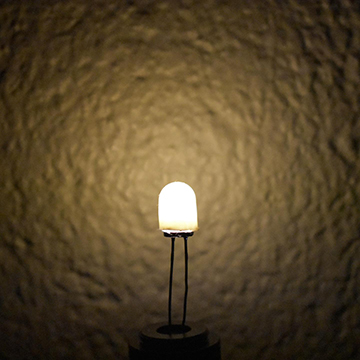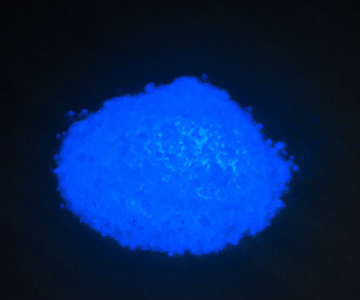
A new prototype LED from University of Houston researchers emits a warm white light, while cutting back on blue wavelength components. [Image: J. Brgoch]
The switch from inefficient incandescent lights to low-energy LEDs has significantly reduced the world’s energy consumption. But it’s also increasing humans’ exposure to blue light, which has been tied to a range of health issues from sleep disturbance to cataracts.
Now, researchers at the University of Houston, USA, have created an LED that gives off daylight-mimicking white light while using less blue light in the process (ACS Appl. Mater. Interfaces doi:10.1021/acsami.1c00909). The team behind the work believes that the device could help alleviate the health issues associated with blue light.
A touch of blue
To create white light that mimics daylight, LEDs are coated with phosphors that shift their limited color range to several different wavelengths that together appear white. This is often achieved using a blue-emitting LED capped with yellow or red phosphors. However, these phosphors only complement or mask the blue light.
One way to cut the blue component would be to use not a blue-emitting LED as the basic light source, but a violet one—and then employing a tunable combination of red-, green- and blue-emitting phosphors to produce the final white light. Unfortunately, though, it’s been tough to find blue phosphors with a sufficiently high photoluminescent quantum yield when excited by violet light. The LED from the University of Houston team uses a new europium-based phosphor that answers that need, allowing a device that can reduce blue light while maintaining a good color balance.
“In order to produce the white light, you do need that blue component,” said lead author, Shruti Hariyani, a Ph.D. student at Houston. “But what our work shows is that you can really minimize that blue component and still create a white light that is reminiscent of sunlight.”
Serendipitous discovery
Hariyani serendipitously discovered the new phosphor when investigating different oxyfluoride systems. In trialing europium and cerium ions as activator ions—the component of a phosphor responsible for making it emit light—in different crystal structures, she came across and interesting combination: Na2MgPO4F:Eu2+. Analyzing the material’s luminescence with a spectrophotometer, Hariyani found it had a bright blue emission that could be excited by a broad range of wavelengths, including those from a violet LED.

Blue light emitted by the new phosphor [Image: S. Hariyani]
“I knew right away that there was something unique to this blue-emitting material that would make it good for a unique purpose,” Hariyani said.
That purpose ended up being more human-friendly lighting. Hariyani and her Ph.D. advisor and associate professor at the University of Houston, Jakoah Brgoch, tested the phosphor in a prototype LED to create a light better suited to human-centric uses. They used the new phosphor in combination with green- and red-emitting phosphors on a violet LED. Analysis of the LED showed it was able to emit white light that had a much smaller blue component than a typical LED.
Toward less-disruptive lighting
The phosphor, which is easily created in a one-step sintering process, was also found to be stable when exposed to water and temperatures up to 150 °C, which makes it available for commercial applications. However, the prototype uses a violet LED; these devices, which are costlier than more widespread blue LEDs, are uncommon in commercial products. As such, the new phosphor likely won’t find immediate commercial use until violet LED prices come down.
Still, the Houston team says the results show that it’s possible to create better balanced lights that are less disruptive to humans. “The light around us,” Brgoch said, “can really influence both our productivity as well as our health.” Brgoch sees the new prototype LED not just as a new light bulb, but as a part of the way forward to creating better lighting systems. “There’s a little bit more meaning behind it.”
